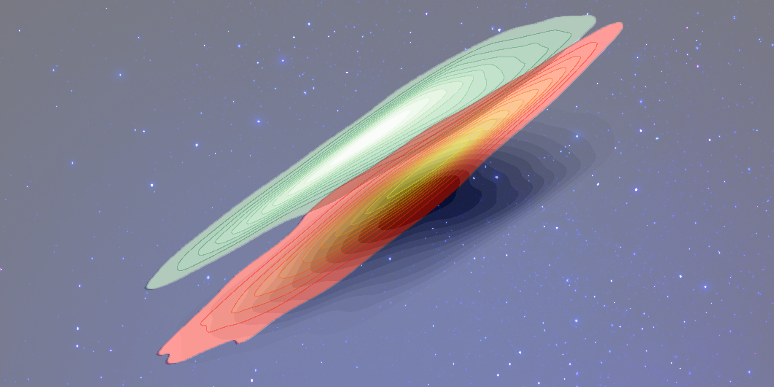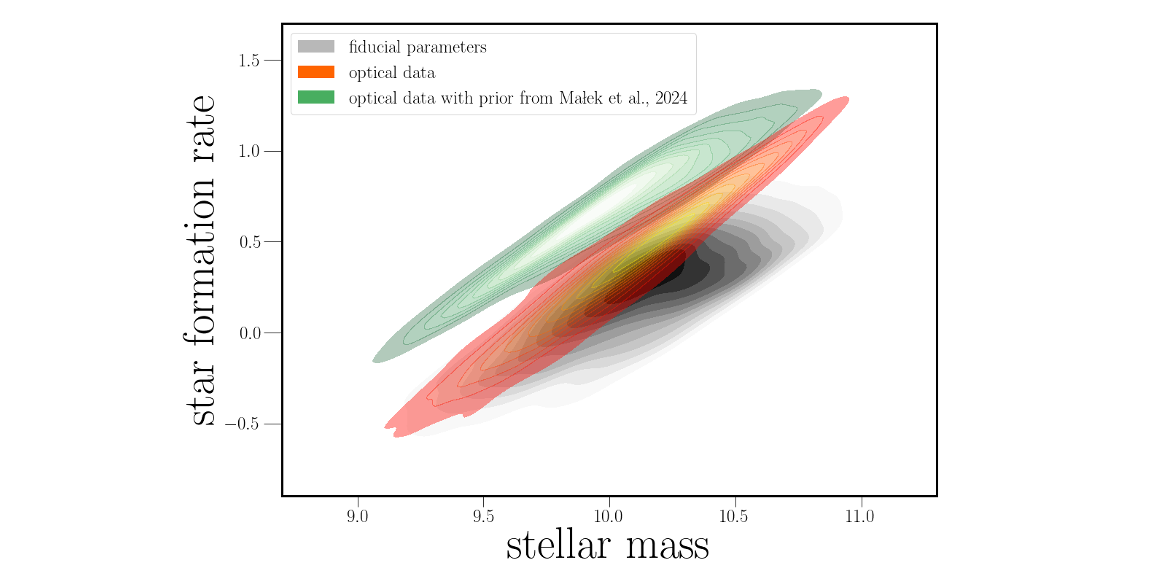
In the Universe, appearance matters: Dusty shapes of colourful galaxies
05-04-2024
Can we see what is hidden in a cloud of dust without the aid of infrared vision? This question applies not only to earthly objects but also to astronomical observations of galaxies - and the answer usually is “no”. Scientists involved in the largest optical survey of the sky this decade, the Legacy Survey of Space and Time (LSST), led by a group from the NCBJ’s Astrophysics Division, in a paper published in April in Astronomy & Astrophysics, propose a novel method to extract information about dust in galaxies without actually observing its infrared light.
Stars being born is a dusty process. Stars in galaxies are always formed enshrouded in clouds of tiny grains of solid material known, also on Earth, as dust. This dust makes the stellar nurseries difficult to observe as it absorbs the optical light of newly born young stars. These dusty star-forming areas in the optical images simply remain dark and invisible. The optical light absorbed by the dust is then re-radiated in the infrared. Thus, the best way to determine the physical properties of a galaxy is to look at the galaxy at all possible wavelengths. The selective view only in specific wavelengths can sometimes give a misleading impression about its fundamental nature. This misunderstanding caused by the dust often distorts our view. For example, massive stars can emit so much energy at visible wavelengths that they appear disproportionately more important than they really are. In addition, the dust that is used to shelter the birth clouds prevents us from seeing a representative picture of the true distribution of stars.
Infrared radiation from dust clouds surrounding star nurseries in galaxies is closely related to the properties of young, massive stars. Newborn stars emit bright ultraviolet light, which is absorbed and scattered by the dust grains and re-emitted by these grains over the entire infrared range. The nature of this radiation depends on the distribution of the dust and stars in a galaxy. This complex relationship reflects the weakening (attenuation) of the intensity of the galaxy's radiation in a given band. Not knowing the exact amount of attenuation at a given wavelength limits the interpretation of fundamental properties of galaxies.
Observing a galaxy from the far ultraviolet (where the young massive stars are partially visible) through optical light (where old stars dominate) to infrared and submillimetre wavelengths (the kingdom of interstellar dust) allows us to analyse and understand its fundamental nature and the amount of interstellar dust. It also allows us to discuss the properties of the galaxy's dust attenuation.
Unfortunately, galaxies with full wavelength coverage, from the ultraviolet to the infrared, are rarely available, creating obstacles to studying them at a significant statistical level. In that situation, analysing an uncompleted view of the galaxy is much more complicated and weighed by assumptions. This problem will become even more urgent and important in the coming era of the Legacy Survey of Space and Time (LSST) from the Vera C. Rubin Observatory.
The Vera C. Rubin Observatory is located on the Cerro Pachón mountain range in north-central Chile. The special 8.4-metre triple mirror detector designed for this observing site provides an exceptionally wide field of view. This mirror allows the entire sky to be scanned in just three nights. By the end of the 10-year LSST survey, we will have scanned the sky so many times that, by combining different images, it will be possible to see what has not been seen before - low surface brightness galaxies that are currently hidden in the background of the sky even for very powerful telescopes, as well as more familiar galaxies, but with much deeper and better detections. The survey will also give us an additional time component by monitoring the sky regularly. However, LSST will not provide the infrared (and ultraviolet) observations. We will have to rely only on the optical range in future analyses.
A worldwide team of researchers from Poland, France, Chile, the United States, Australia, the United Kingdom, Italy, Mexico, the Netherlands and Spain led by Prof. Katarzyna Małek and dr Junais under the NCB SONATA BIS ASTROdust grant and Prof. Agnieszka Pollo from the National Centre for Nuclear Research has analysed previous archive surveys to find a solution to this problem. They looked at galaxies in our nearest neighbourhood, less than 1.3 billion light-years from the Milky Way, and studied the morphology, dust properties, star formation and stellar mass ratios of more than eight thousand galaxies. They found a very promising relationship for the next optical surveys like LSST between surface brightness, optical colour (where colour in astronomy is the difference in energy observed in two different wavelength filters) and dust attenuation. This relationship can be used to estimate the dust properties of galaxies observed only in the optical wavelength window. It will also help to minimise computational time and environmental impact by reducing the number of parameters used to estimate the main physical properties of these galaxies.
They have found that the dust attenuation of the young stellar population, obtained from optical data only and used for complex galaxy analysis, can reasonably reproduce the main physical parameters of galaxies observed by detailed detection in the ultraviolet, optical and infrared surveys. The comparison between fiducial physical parameters from the extensive surveys and the physical parameters obtained based on their optical data only with and without the ‘guess’ obtained based on the relation discovered in this work is shown in Figure below. The relation works very well with less massive galaxies, while the obtained star formation rate is still overestimated for the more massive ones. The same group of researchers will cover this problem in the following articles.
Scientists from the Astrophysics Department of the National Centre for Nuclear Research participated in the analysis: dr. Mahmoud Hamed. dr. Michael Romano, dr. Darko Donevski, dr. Ambra Nanni, dr. William J. Pearson, dr. Francesco Pistis and dr. Gabriele Riccio.
This study was published in Astronomy & Astrophysics: Małek, Junais, Pollo et al., Astronomy & Astrophysics https://www.aanda.org/articles/aa/full_html/2024/04/aa48432-23/aa48432-…

Fiducial physical parameters (stellar mass and the star formation rate) of ~8,000 galaxies observed in the ultraviolet, optical and infrared wavelengths are presented in black. The physical parameters obtained for the same galaxies based only on the optical data, for example, from LSST, are shown in green. The orange plot shows galaxies for which physical properties are calculated using optical only information, as in the case of the green one, but with additional ‘’guesses’ from the relation provided by the team led by Katarzyna Małek




